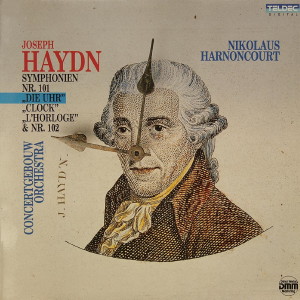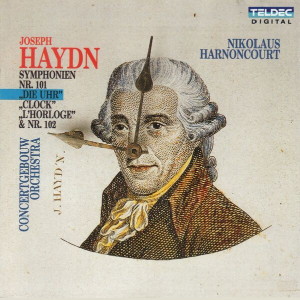 |
1 LP -
6.44091 AZ - (p) 1988
|
 |
| 1 CD -
8.44091 ZK - (p) 1988 |
|
| Franz Joseph
Haydn (1732-1809) |
|
|
|
|
|
|
|
Symphonie Nr. 101 D-dur, Hob.
I/101 "Die Uhr"
|
|
28' 07" |
|
| - Adagio - Presto |
8' 09" |
|
A1 |
- Andante
|
8' 40" |
|
A2 |
- Menuet: Allegretto - Trio
|
5' 56" |
|
A3 |
| - Finale: Vivace |
5' 22" |
|
A4 |
| Symphonie
Nr. 102 B-dur, Hob. I/102 |
|
23' 25" |
|
- Largo - Vivace
|
8' 41" |
|
B1 |
| - Adagio |
5' 04" |
|
B2 |
| - Menuet: Allegro - Trio |
4' 54" |
|
B3 |
- Finale : Presto
|
4' 46" |
|
B4 |
|
|
|
|
| CONCERTGEBOUW ORCHESTRA,
AMSTERDAM |
|
| Nikolaus
Harnoncourt, Dirigent |
|
|
Luogo
e data di registrazione
|
| Concertgebouw,
Amsterdam (Olanda) - gennaio &
febbraio 1988 |
|
Registrazione
live / studio
|
| studio |
Producer
/ Engineer
|
Wolfgang
Mohr / Helmut A. Mühle / Michael Bramman
|
Prima Edizione CD
|
| Teldec
- 8.44091 ZK - (1 cd) - 51' 55" - (p)
1988 - DDD |
Prima
Edizione LP
|
Teldec - 6.44091
AZ - (1 lp) - 51'
55"
- (p) 1988 - Digital
|
|
|
Notes
|
Joseph Haydn ist the
greatest “surprise composer" in
the history of Classical music. The
music-lover who seeks points of
agreement between a
composer's life and
his work will certainly find them in
the harmonic rounding-off of Haydn’s
music, but his inexhaustible
creative imagination stands in
contrast to an austere private
existence. Haydn’s life was entirely
lacking in sensation: his was a
domestic nature, and his patient
character protected him from undue
eruptions of feeling. Though by no
means as naive a man as Bruckner, he
shared with his fellow Austrian a
touching modesty that enables one to
approach his works unprejudiced
by colourful anecdotes. A Berlioz,
it is true, was made so “fidgety” by
the “Creation", with its “sunrise in
C... and all the other worthy
features, that I feel the urge to
kill someone." But the nervous
hyper-Romantic Berlioz was an
exception, and patience, especially
the patience required to listen to
somebody else, was not his strong
point. Listening to Haydn, however,
demands just that:
the patience to recognise and enjoy
that wealth of invention with which
he was so lavish. Ferdinand Hiller
(1811-1885) was probably the first
of his generation to recognise
Haydn's greatness and the diversity
of his genius. In
his “Letters to an anonymous person”
(1877), we find one of the most
appealing sketches of what Haydn was
capable of: "...For some time now I have begun my
day’s work with a most delightful
morning blessing: I read a quartet
by Haydn every day, and even the
most pious Christian cannot derive
more benefit from a chapter of the
Bible... If everyone could read
music, Haydn would be one of
mankind’s greatest benefactors... He
possessed a rich imagination, charm,
good health, a sense of humour, he
had fine taste, a good brain, warmth
of feeling and a cheerful
disposition, he was quiet yet
lively, original yet easy to
understand, he possessed freedom and
moderation, depth and clarity,
knowledge and experience. He was
able to calculate while playing, and
he seems to be at play when he is
actually calculating. He combines
childlike naivety with the absolute
confidence of the most mature and
reasonable man, he combines the
tender devotion of the improviser
with the logic of the strict
thinker..."
All these qualities listed by the
great Romantic musician can be found
in the two symphonies recorded here,
which belong to the series of the
twelve London symphonies, nos.
93-104: not all of these enjoy the
same degree of “popularity",
one should add. The D major Symphony
No. 101 was written during Haydn’s
second stay in London, and has the
nickname "The Clock”, derived from the
pendulum movement at the beginning of
the andante. The four-movement work,
the opening presto of which is
preceded by an adagio introduction,
was given its first performance under
the composers direction in the year of
its composition, 1794, in the series
of concerts put on by the impresario
Salomon. Everything about this
symphony is “Classical” - and yet free
of any kind of scheme. This
is true not only of the structure of
the first movement, in
which Haydn restricts himself to
sonata form; it applies equally to the
andante, consisting of a song theme
and variations, to the third movement
(minuet and trio) and the magnificent
finale, a rondo interspersed with
counterpoint.
Symphony no. 102 in B flat major is
not as well known as its sister work,
but it is more important in stylistic
terms. Like no. 101, it has a long
introduction full of tension that
comes at the beginning of the first
movement. In this
opening movement, the elements later
used by the symphonic dramatist
Beethoven are already in evidence. The
second movement, an adagio, likewise
contains forward-looking features,
attractively polished into many
different facets. An exquisitely
earthbound minuet with cryptic
symphonic undercurrents occupies third
place together with its lighterweight
trio. But here too we find a driving
energy in places, to which Beethoven
and Schubert later only had to refer
back. The rondo finale is full of
stylistic, harmonic and dynamic
surprises: beginning as a dance, it
culminates in a breathtaking presto
farewell. Symphony no. 102 was first
performed on 2nd February 1795 in
London - not in Salomon’s concert
series, however, but at one of the
opera concerts organised by the
ltalien violinist and composer Viotti
at the King's Theatre in Haymarket.
The two symphonies offered on this
disc belong in the ranks of those
works with which Haydn individualised
the genre to such an extent that it
was no longer sufficient for a
symphony to represent a qualified
orchestral piece in several movements;
henceforth it had to
be an unmistakable document of its
author’s creative individuality. Thus
the path Beethoven was to follow was
already mapped out -
the marvellous rhythmic capers in the
finale of Haydn’s no.
102 provide ampel evidence of this.
Knut
Franke
Translation: Clive Williams
|
|
Nikolaus
Harnoncourt (1929-2016)
|

|

|
|